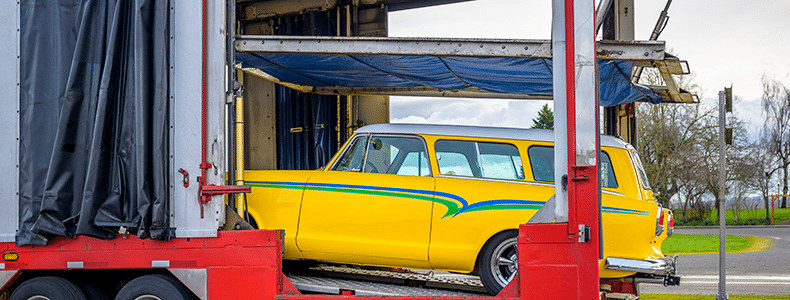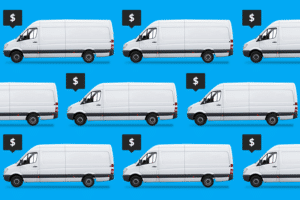Shipping a vehicle to a new destination can be a major expense. Without properly understanding the likely costs involved, you may end up paying more than expected or choosing a less-than-ideal transport option. It is important to educate yourself on the key factors that influence the cost to ship different vehicles, such as distance, vehicle type, transport method, and more.
The goal is to secure safe, reliable, and cost-effective transportation for your vehicle. This is where uShip can help. uShip is an online marketplace that allows you to receive competitive quotes from trusted auto transporters nationwide. By entering details about your vehicle and shipment needs, you can compare real-time quotes to find the best balance of service quality and affordability.
The quoting process through uShip is free and easy. You describe your car and shipment details, and transporters will provide customized quotes based on their availability, expertise, and desired profit margins. This empowers you to make an informed, cost-conscious decision when selecting your transporter.
As we explore the vehicle shipping process, consider cost considerations. An educated decision can help you avoid surprise charges or falling for suspicious deals that seem too good to be true. Please read on for more helpful guidance on securing reliable, protection-inclusive, and fairly priced vehicle transport through trustworthy providers found on uShip.
TYPE OF VEHICLE BEING SHIPPED

The costs associated with shipping your vehicle can vary significantly depending on the type of vehicle and its unique characteristics. When researching vehicle transport options and quotes, it is important to understand how the size, weight, and shipment considerations of different vehicle categories impact the baseline rates and cost factors.
Cars and Motorcycles
Transporting standard passenger vehicles like cars, trucks, or motorcycles is the most affordable vehicle transport option. Key factors that influence cost of shipping cars and motorcycles include:
- Distance and Miles Traveled: Longer distances mean higher fuel usage and longer transport times for the driver—resulting in higher base rates. Extra expenses like lodging and meals also add up.
- Vehicle Size and Weight: Larger vehicles take up more space on trailers, limiting capacity. Heavier vehicles also impact fuel efficiency and may require specialized equipment, driving up costs. Compact cars and motorcycles ship for less.
- Seasonal Demand: Peak summer and winter moving seasons see higher demand, which enables transporters to charge premium rates. Fall/spring shipments tend to cost less.
Boats and RVs
Shipping higher-value boats and recreation vehicles brings unique expenses resulting from their larger size, heavier weight, and added protection requirements. For example, many locations impose width restrictions, which may require a pilot car and special permits, adding hundreds of dollars. The cost grows with boat size.
Specialized trailers are needed to transport extra weight safely, limiting transporter options. Rushing delivery to coordinate with planned vacations also incurs premium upcharges.
Enclosed shipping and supplemental protection raise costs but protect from weather and road debris. This is wise for protecting expensive RVs and boats in transit.
Heavy Equipment
Finally, transporting commercial equipment, agriculture machinery, or other heavy equipment vehicles often requires special permits and can costs thousands for a single shipment. Variables like height, ground clearance, and liquid loads require experienced transporters to charge premium rates. For example:
Depending on a load’s dimensions, escort vehicles, and routing planning may be required. This detailed coordination results in rate markups.
To secure heavy cargo safely, low-bed trailers, ramps, chains and straps, and load bars must be used. This specialized equipment is scarcer and drives up costs. Ensure your carrier has the proper equipment and experience shipping heavy equipment before booking. This information should be easy to find on their carrier profile.
SHIPPING DISTANCE AND LOCATION
Domestic vehicle transport within the contiguous United States tends to be significantly less expensive and complex than international shipments. Average costs for a 1,000-mile domestic vehicle shipment may run a few hundred to a few thousand dollars, depending on vehicle type. International shipments often cost thousands more, even for shorter distances.
Beyond base shipping rates, international transport costs pile on more quickly due to more complex customs procedures, overseas hauling distances, marine insurance requirements, and reliance on specialty international freight brokers. The vehicle must clear customs declarations and inspections at origin and destination ports, adding layers of paperwork, delays, and terminal handling fees.
Transporters must meet international shipping regulations regarding crating, blocking, and bracing standards, trailer security, and quantity and weight limitations, further driving up process costs.
There are also more logistical considerations around loading and unloading with international boat transport. Enclosed container transport is preferred, but it is more expensive, and customs clearance becomes more complex with this method. The vehicles must also be adequately prepared for close-stacking in containers, and tie-down equipment differs from open-air trailer methods. Route planning is more difficult as well—shipment tracking can lapse between marine transport hand-offs, and drivers must strategically book payload return trips to avoid long-distance empty hauls back from ports.
URBAN VS. RURAL DESTINATIONS
Shipping vehicles to urban regions with denser road infrastructure and easily accessible loading facilities generally costs less than transport to remote rural areas. Cost factors relating to rural and off-grid locations include:
- Mileage Inefficiency: Significant distances between rural destinations and major highways reduce fuel efficiency. More back-road driving also increases transport hours for truckers paid by the mile. Long remote trips build in higher rate costs.
- Loading/Unloading Logistics: Rural properties often lack proper loading and off-loading docks and equipment. The inability to utilize ramps and forklifts, navigating dirt or gravel roads, or inclement weather conditions slows the process. Waiting time surcharges frequently apply.
While rural transport adds difficulties, experienced carriers familiar with remote areas can provide creative solutions at fair prices. Door pickup and drop-off service is also commonly available.
MODE OF TRANSPORTATION IS ONE OF THE CRUCIAL FACTORS
Two main options exist when selecting a vehicle shipping method: open auto carriers or enclosed trailers. Each mode has trade-offs in terms of affordability, protection level, and shipment timeliness.
Open Auto Carriers
This is the most common transport mode used by professional vehicle shipment companies. Vehicles are loaded in open air on multi-level steel trailers designed for vehicles.
Pros:
- Lower Cost: Open shipping starts at $600 for regional, $1,500+ for cross-country.
- Faster Loading: Multi-vehicle ramp loading is quicker.
- Flexible Capacity: No size restrictions are beyond the trailer bed.
- Provides Basic Protection: Vehicles are strapped down tightly.
Cons:
- Exposure Risk: Long-distance weather and road debris will be more likely to cause damage.
- Limited Protection: Vehicles exposed to the elements.
- Insurance Challenges: Storm damage claims are difficult to confirm.
Enclosed Trailers
Enclosed trailers offer a complete housing shell that fully contains and protects vehicles from road hazards. This mode is preferred for vintage, luxury, or delicate vehicles.
Pros:
- Maximum Protection: Shell blocks weather and debris during transport.
- Individual Loading: Vehicles do not risk scratching each other.
- Insurance Coverage: It’s easier to confirm shipment damage claims.
Cons:
- Higher Cost: $900+ for regional, $1,800+ for enclosed long-haul
- Slow Loading/Off-loading: Individual vehicle access takes longer
Specialized Equipment
Heavier vehicles like buses, agriculture equipment, high-value boats, or large machinery often require special haulers designed to uniquely handle oversize vehicles. These have higher costs for operators given specialized winches, reinforced ramps, and padding materials needed to transport heavy cargo safely.
HOW SEASONS AND MARKET DEMAND INFLUENCE CAR SHIPPING COSTS
When planning a big move or vehicle relocation, timing becomes critical, especially for budget-conscious individuals. The cost to hire an auto transport carrier can shift thousands of dollars depending entirely on market conditions. This section breaks down how seasonal peak cycles and transportation market trends directly impact shipping rates.
Peak Season vs Off-Season Pricing
The auto transport industry experiences seasonal “peak” periods each summer and winter. Long-distance consumer moves spike around these periods:
- Summer Peak (May-August): Warmer weather and school holidays accommodate household moves. Increased recreational vehicle and college student transport take place.
- Winter Peak (November – February): Snowbird migration to warmer climates increases alongside holiday travel and annual moves to align with school calendars.
Off-peak spring and fall seasons have milder road conditions and lower industry volumes, making autumn an ideal window for value vehicle shipping. Transporters offer discounted pricing to fill excess capacity and keep trucks moving. Competition gets steeper; consumers see significant rate drops during September-October and March-April shipment lulls.
Market Trends and Fuel Impact
During the past decade, large-scale trends have also emerged, drastically impacting transport costs:
- Fuel Price Fluctuations: As diesel prices rose drastically in 2022, carriers passed fuel surcharges directly to consumers.
- Vehicle Inventories: New and used car shortages limited consumer purchase options, so more sought transport of existing owned vehicles rather than replacement. Transport orders spiked with further rate hikes.
Both seasonal peaks and broader economic factors like high summer fuel pricing can greatly influence vehicle shipping costs. Being an informed consumer on price cycles can save hundreds of dollars when planning movements. Consider leveraging off-season bargains this fall
KNOWING ABOUT INSURANCE AND ADDITIONAL PROTECTION
When you hire an auto transport company to ship your vehicle to a new destination, additional protection coverage protects you in case any damage occurs during transit. Car shipping protection alleviates the customer’s financial liability for potential repairs or loss from when the car leaves its possession through its safe delivery.
Carrier Insurance
Federal regulations require all US auto carriers to obtain up to $750,000 in general liability insurance. However, this lump coverage applies to their entire fleet—not per vehicle. If you share a trailer with four other cars, you only have access to 1/5 of that coverage cap if damages do occur.
Carriers’ base policies mainly protect themselves, not your assets specifically. Their terms favor deductibles, exclusions, and settlement depreciations working against the car owner’s best interest if something happens en route. Always verify coverage specifics like storm damages waivers, theft clauses, and settlement rate caps when reviewing initial carrier insurance offerings.
Private Insurance
Some personal auto insurance companies extend policies to cover vehicles under transport contracts. However, locked storage, commercial towing, and shipping trailers often operate in gray areas or gaps concerning standard agreements. Contact your insurer to request confirmation of continuous coverage while your car is being hauled.
To purchase easy, no-hassle coverage that provides extra protection for your vehicle shipment, consider purchasing a uShip Protection Plan at checkout.
CONCLUSION
When arranging to ship a vehicle to a new destination, understanding the cost factors involved leads to maximum savings. To recap key points:
- Vehicle Type: Larger vehicles cost more to ship based on size, MPG impacts, and specialty equipment needs.
- Transport Mode: Enclosed trailers versus open carriers.
- Distance and Location: Rural, remote areas have limited access and fewer carrier options.
- Seasonality and Fuel Prices: Peak summer and winter rates can be higher than fall or spring.
With so many variables impacting auto transport quotes, it pays to leverage market competition by getting multiple free bids from top-rated carriers in uShip’s online marketplace. uShip enables you to enter details for your specific vehicle and shipment route at the same time. Our system distributes your request to our network of thousands of independent transport companies.
Carriers then directly provide custom quotes based on their optimal pricing, availability, and capabilities in handling your vehicle type, timing needs, and destination. The range of options facilitates comparing rates and reviews across reputable companies to find your best shipment match.
Take advantage of uShip’s seamless platform to receive no-obligation quotes catered to your situation. Identify the ideal blend of reliability, protection, and value for your upcoming vehicle transportation.
MOST COMMON QUESTIONS PEOPLE ALSO ASK (PAA):
How much does it cost to ship a car across the country?
The average cost for coast-to-coast auto transport can range from $500 to a few thousand dollars, depending on a range of factors. Exact rates vary based on vehicle size, time of year, and drop-off location accessibility.
What factors affect the cost of shipping a motorcycle?
Key factors that impact motorcycle shipping costs include transport distance, shipment date flexibility, and enclosed vs. open trailer options.
Is it more expensive to ship a vehicle internationally?
Yes, international vehicle shipping costs significantly more than domestic transportation. The base ocean freight and air freight costs, import duties, overseas port handling fees, and complex customs paperwork/processing all contribute to very high shipment rates.
How do seasonal fluctuations affect vehicle shipping rates?
Peak summer and winter moving periods usually see rates increase over off-season pricing. Higher demand allows carriers to charge premium rates, while fall and spring offer better bargains.
What kind of insurance do I need when shipping a vehicle?
While basic liability from carriers is included, added protection from uShip is recommended for your total peace of mind.
Can I ship personal items in my car during transport?
Most carriers allow nonhazardous personal items in trunks during enclosed transport only. Value, availability, and contents differ by company. Confirm policies before loading vehicles.



